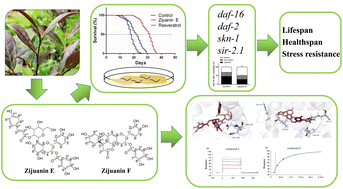Two new catechins from Zijuan green tea enhance the fitness and lifespan of Caenorhabditis elegans via insulin-like signaling pathways†
Abstract
Green tea polyphenols show positive effects on human health and longevity. However, knowledge of the antiaging properties of green tea is limited to the major catechin epigallocatechin gallate (EGCG). The search for new ingredients in tea with strong antiaging activity deserves further study. Here we isolated and identified two new catechins from Zijuan green tea, named zijuanin E (1) and zijuanin F (2). Their structures were identified by extensive high-resolution mass spectroscopy (HR-MS), nuclear magnetic resonance (NMR), ultraviolet–vis (UV), infrared (IR) and circular dichroism (CD) spectroscopic analyses, and their 13C NMR and CD data were calculated. We used the nematode Caenorhabditis elegans (C. elegans) to analyze the health benefits and longevity effects of 1 and 2. Compounds 1 and 2 (100 μM) remarkably prolonged the lifespan of C. elegans by 67.2% and 56.0%, respectively, delaying the age-related decline of phenotypes, enhancing stress resistance, and reducing ROS and lipid accumulation. Furthermore, 1 and 2 did not affect the lifespan of daf-16, daf-2, sir-2.1, and skn-1 mutant worms, suggesting that they might work via the insulin/IGF and SKN-1/Nrf2 signaling pathways. Meanwhile, 1 and 2 also exhibited strong antioxidant activity in vitro. Surface plasmon resonance (SPR) evidence suggests that zijuanins E and F have strong human serum albumin (HSA) binding ability. Together, zijuanins E and F represent a new valuable class of tea components that promote healthspan and could be developed as potential dietary therapies against aging.

- This article is part of the themed collection: Food & Function HOT Articles 2022


 Please wait while we load your content...
Please wait while we load your content...